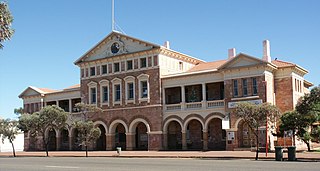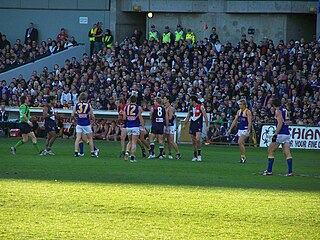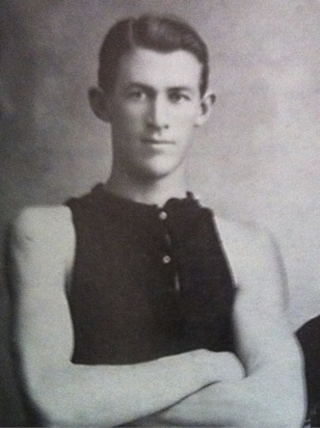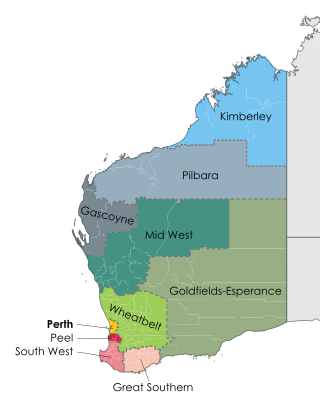Related Research Articles

The West Australian Football League is an Australian rules football league based in Perth, in Western Australia. The league currently consists of ten teams, which play each other in a 20-round season usually lasting from April to September, with the top five teams playing off in a finals series, culminating in a Grand Final. The league also runs reserves, colts (under-19) and women's competitions.

Coolgardie–Esperance Highway is a 370-kilometre (230 mi) Western Australian highway between Coolgardie and Esperance. It runs in a north–south direction linking the state's Eastern Goldfields to the coast.

Coolgardie is a small town in Western Australia, 558 kilometres (347 mi) east of the state capital, Perth. It has a population of approximately 850 people.

In Western Australia (WA), Australian rules football is the most popular sport. There are 29 regional club competitions, the highest profile of which is the semi-professional West Australian Football League. It is governed by the West Australian Football Commission (WAFC). It has 108,154 adult players and 46,187 children, the highest participation rate per capita (8.5%) in Australia, second most players of any jurisdiction, accounts for around a fifth of all players nationally and is growing faster than any other state. It is the third most participated team sport after soccer and basketball.

East Fremantle Oval is an Australian rules football ground located in East Fremantle, Western Australia. The ground was opened in 1906, and underwent a large redevelopment in 1953. It current serves as the home ground of the East Fremantle Football Club in the West Australian Football League (WAFL). East Fremantle Oval has a capacity of around 20,000 people, but has hosted in excess of this number previously, with a record crowd of 21,317 for a match between East Fremantle and South Fremantle in the 1979 season.
The Eastern Goldfields is part of the Western Australian Goldfields in the Goldfields-Esperance region of Western Australia, covering the present and former gold-mining area east of Perth.
The Goldfields Football League is an Australian rules football league based in the Goldfields region of Western Australia. Founded in 1896 as Hannans District Football Association, the league enjoyed a seat and full voting rights on the Australian National Football Council until 1919. The first clubs to play Australian football were formed within the region, and the league helped popularise the sport in the region, helping to establish the sport and supplant Rugby in popularity. The GFL was known as the Goldfields Football Association (GFA) from 1901–07 and 1920–25, and as the Goldfields National Football League (GNFL) from 1926–87.
John Cameron Sheedy was an Australian rules footballer and coach. He played for East Fremantle and East Perth in the Western Australian National Football League (WANFL) and South Melbourne in the Victorian Football League (VFL). Sheedy is considered one of the greatest ever footballers from Western Australia, being the first player from that state to play 300 games in elite Australian rules football, and was a member of both the Australian Football Hall of Fame and the West Australian Football Halls of Fame.

William John "Nipper" Truscott Jr. was an Australian sportsman. He played over 300 games of Australian rules football for Mines Rovers in the Goldfields Football League (GFL) and East Fremantle in the West Australian Football League, and represented Western Australia at football, cricket and lawn bowls. He was inducted into the Sport Australia Hall of Fame in 1985 and the Australian Football Hall of Fame in 1996.

Charles Edward Tyson was an Australian rules footballer who played with Collingwood and North Melbourne in the Victorian Football League during the 1920s.

Thomas Outridge was an Australian rules football player and administrator. Originally from Ballarat, Victoria, he played 201 games for Perth and Subiaco in the West Australian Football League (WAFL), and also represented Western Australia in 25 interstate matches, captaining the side at the 1930 Australian National Football Carnival. Outridge was also the winner of the inaugural Sandover Medal, in 1921.
Adolphos Heinrich Julius Carl "Dolph" Heinrichs was an Australian rules footballer who played with East Fremantle and North Fremantle in the West Australian Football Association (WAFA). He also represented the Western Australian cricket team in two first-class cricket matches.
The West Australian State Premiership was an Australian rules football match contested intermittently between 1902 and 1924 between the premiers of the Western Australian Football Association / West Australian Football League and the Goldfields Football Association / Goldfields Football League.
William Charles Gordon Thomas was an Australian rules football player, coach, and administrator who was involved with the East Perth Football Club in the Western Australian National Football League (WANFL) in a number of roles from the 1920s to the 1950s. Thomas played 114 games for the club from 1927 to 1936, having previously played for the Kalgoorlie City Football Club in the Goldfields National Football League (GNFL). He won best and fairest awards with East Perth in 1928 and 1929, also winning the Sandover Medal in the latter season. After his retirement, Thomas served as club secretary and club president, as well as coaching the club in 1942, when the competition was age-restricted due to the Second World War.

Domenick Louis "Don" Marinko was an Australian rules footballer who played for the Subiaco and West Perth Football Clubs in the Western Australian National Football League (WANFL) and the Boulder City Football Club in the Goldfields Football League (GFL). Born in the Goldfields region of Western Australia, he was educated at Christian Brothers' College in Perth, and made his senior debut for Subiaco in 1923, at the age of 16. The following season, Marinko returned to the Goldfields in order to find work in the mines, and took up playing for the Boulder City Football Club in the Goldfields Football Association (GFA), playing in premierships in 1924 and 1925. Returning to Perth, he fell into West Perth's zone, and began playing with the club in 1926. Marinko played in premiership sides for West Perth in 1932, 1934, and 1935, and was captain of the club for the latter two seasons. At his retirement in 1939, he had played 194 games for the club, and 197 games total in the WAFL, as well as playing thirteen interstate matches for Western Australia. Having died in 1967 from a sudden heart attack, Marinko was named in West Perth's Team of the Century in 2000, and inducted into the West Australian Football Hall of Fame in 2011.

Kyal Horsley is an Australian rules footballer who formerly played for the Gold Coast Football Club in the Australian Football League (AFL). Originally from Kalgoorlie, Western Australia, he previously also played with the Kalgoorlie City Football Club in the Goldfields Football League (GFL) and the Subiaco Football Club in the West Australian Football League (WAFL), where he finished runner-up in the 2011 Sandover Medal to Luke Blackwell. Horsley was drafted by Gold Coast with the second pick in the 2012 Rookie draft, and made his debut for the club in round five of the 2012 season. He was delisted by the club at the end of the 2013 season, after 14 games. Horsley returned to the Subiaco Football Club in 2014 to captain the WAFL side for the 2014 season. Horsley had a powerful return to the WAFL finishing third in the Sandover Medal count after leading the Lions to their 12th premiership.

Rugby union in Western Australia describes the sport of rugby union being played and watched in the state of Western Australia. First introduced some time in 1868 it was the most popular football code until it was overtaken by Australian rules there in 1885. After a period of decline and recess between 1905 and 1927 it grew throughout the 20th century. The governing body is the Western Australia Rugby Union (RugbyWA).
The Coolgardie Miner was a weekly newspaper established in Coolgardie, Western Australia, at a time when Coolgardie was the prominent town in the goldfields region of Western Australia.

This is a list of newspapers published in, or for, the Goldfields–Esperance region of Western Australia.
Mines Rovers Football Club is an Australian rules football team playing in the Goldfields Football League, a league based in the Goldfields region of Western Australia. Founded in 1898 as Mines Football Club, the club has enjoyed a long-standing involvement in the league. One of the first clubs to play Australian football formed within the region, and helped popularise the sport, and supplant Rugby in popularity. The GFL was known as the Goldfields Football Association (GFA) from 1901 to 1907 and 1920–25, and as the Goldfields National Football League (GNFL) from 1926 to 1987. Mines Rovers play home games at Digger Daws Oval, one they are co tenants with other GFL member, Boulder City Football Club. Mines Rovers currently hold the record for most premierships in the GFL with 43.
References
- ↑ "WA's wealth is again in gold" – Western Mail . Published Thursday, 10 August 1939. Written by Alex Barras. Retrieved from Trove, 5 September 2011.
- ↑ "Hannans Football Club" – Western Argus . Published Saturday, 11 May 1895. Retrieved from Trove, 5 September 2011.
- ↑ "Proposed visit of West Perth Club to Coolgardie" – Western Mail . Published Friday, 8 May 1896. Retrieved from Trove, 5 September 2011.
- ↑ "Kalgoorlie Football Association" – Western Mail . Published Friday, 6 August 1897. Retrieved from Trove, 5 September 2011.
- ↑ "The Coolgardie Team entertained in St. George's Hall" – The Inquirer and Commercial News Illustrated. Published Friday, 4 September 1896. Retrieved from Trove, 5 September 2011.
- ↑ "Match against the combined juniors" – The Inquirer and Commercial News Illustrated. Published Friday, 4 September 1896. Retrieved from Trove, 5 September 2011.
- ↑ " "The Veteran's" Notes " – The Inquirer and Commercial News Illustrated. Published Friday, 18 September 1896. Retrieved from Trove, 5 September 2011.
- 1 2 Goldfields Football Association. East Perth's tribute" – Western Argus . Published Tuesday, 4 May 1920. Retrieved from Trove, 5 September 2011.
- ↑ Farewell to Mr. Brett – Western Argus . Published Tuesday, 4 July 1922. Retrieved from Trove, 5 September 2011.
- ↑ Norseman, Western Australia – Scoreboard Pressure. Published 7 August 2011. Written by Vin Maskell. Retrieved 5 September 2011.
- ↑ WA State Premiership [usurped] – FullPointsFooty. Retrieved 5 September 2011.